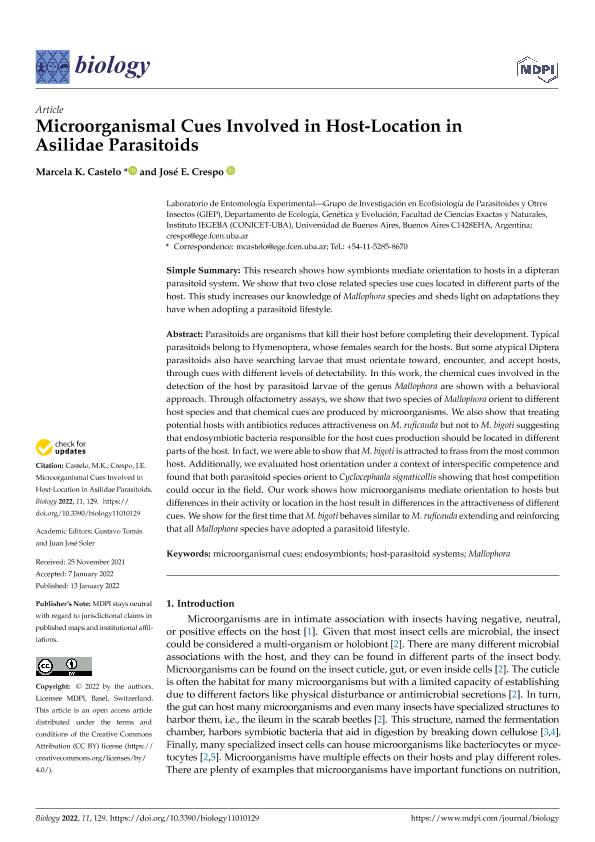Artículo
Microorganismal Cues Involved in Host-Location in Asilidae Parasitoids
Fecha de publicación:
01/2022
Editorial:
MDPI
Revista:
Biology
ISSN:
2079-7737
Idioma:
Inglés
Tipo de recurso:
Artículo publicado
Clasificación temática:
Resumen
Parasitoids are organisms that kill their host before completing their development. Typical parasitoids belong to Hymenoptera, whose females search for the hosts. But some atypical Diptera parasitoids also have searching larvae that must orientate toward, encounter, and accept hosts, through cues with different levels of detectability. In this work, the chemical cues involved in the detection of the host by parasitoid larvae of the genus Mallophora are shown with a behavioral approach. Through olfactometry assays, we show that two species of Mallophora orient to different host species and that chemical cues are produced by microorganisms. We also show that treating potential hosts with antibiotics reduces attractiveness on M. ruficauda but not to M. bigoti suggesting that endosymbiotic bacteria responsible for the host cues production should be located in different parts of the host. In fact, we were able to show that M. bigoti is attracted to frass from the most common host. Additionally, we evaluated host orientation under a context of interspecific competence and found that both parasitoid species orient to Cyclocephaala signaticollis showing that host competition could occur in the field. Our work shows how microorganisms mediate orientation to hosts but differences in their activity or location in the host result in differences in the attractiveness of different cues. We show for the first time that M. bigoti behaves similar to M. ruficauda extending and reinforcing that all Mallophora species have adopted a parasitoid lifestyle.
Palabras clave:
ENDOSYMBIONTS
,
HOST-PARASITOID SYSTEMS
,
MALLOPHORA
,
MICROORGANISMAL CUES
Archivos asociados
Licencia
Identificadores
Colecciones
Articulos(IEGEBA)
Articulos de INSTITUTO DE ECOLOGIA, GENETICA Y EVOLUCION DE BS. AS
Articulos de INSTITUTO DE ECOLOGIA, GENETICA Y EVOLUCION DE BS. AS
Articulos(OCA CIUDAD UNIVERSITARIA)
Articulos de OFICINA DE COORDINACION ADMINISTRATIVA CIUDAD UNIVERSITARIA
Articulos de OFICINA DE COORDINACION ADMINISTRATIVA CIUDAD UNIVERSITARIA
Citación
Castelo, Marcela Karina; Crespo, José Emilio; Microorganismal Cues Involved in Host-Location in Asilidae Parasitoids; MDPI; Biology; 11; 1; 1-2022; 1-13
Compartir
Altmétricas




